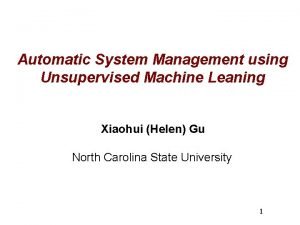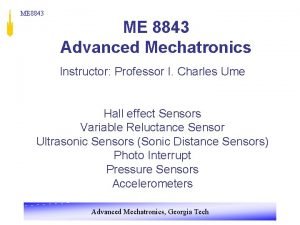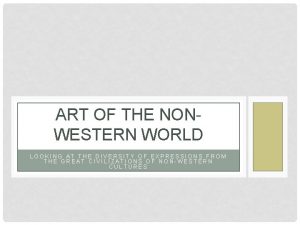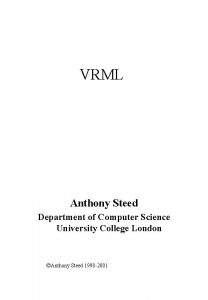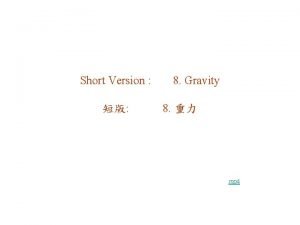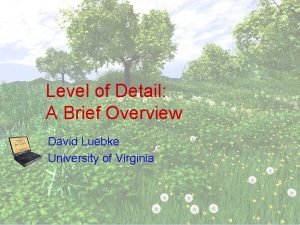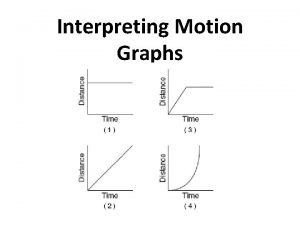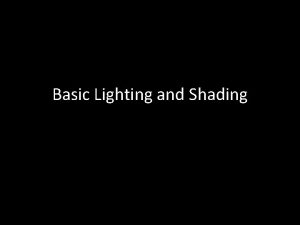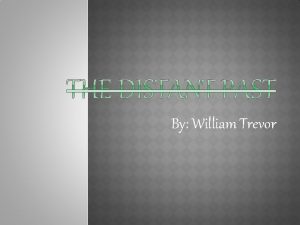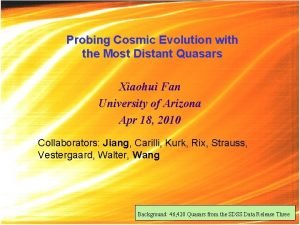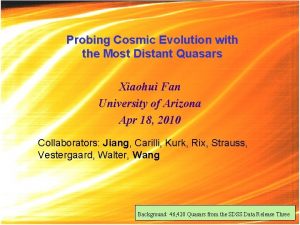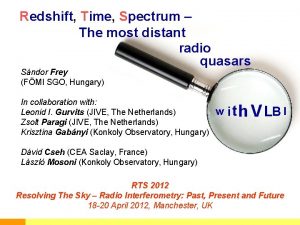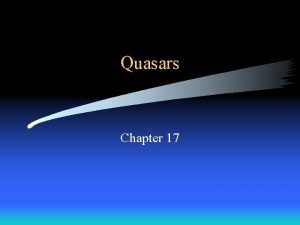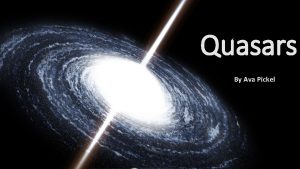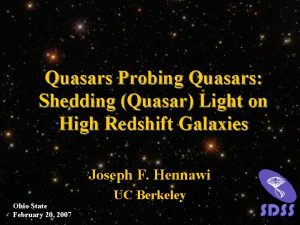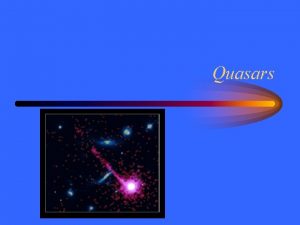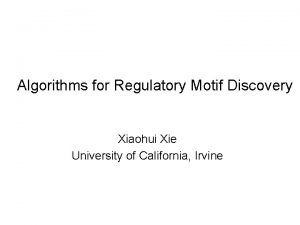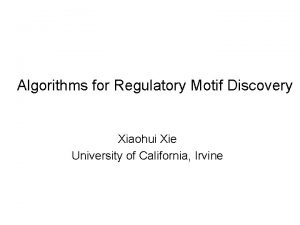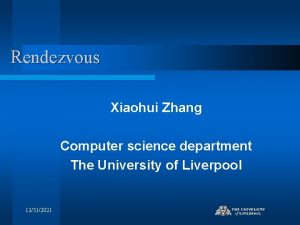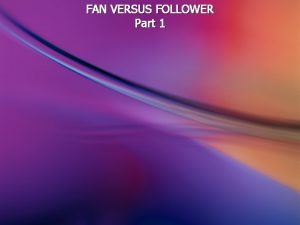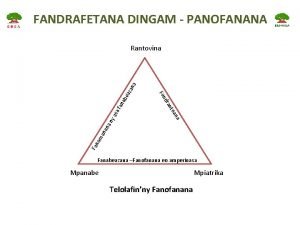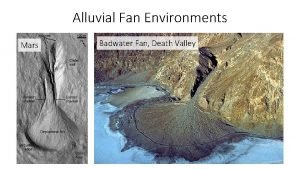The Most Distant Quasars Xiaohui Fan University of















![Probing quasar host galaxies at high-z [OIII] Direct imaging: hard! Radio/sub-mm! CO Probing quasar host galaxies at high-z [OIII] Direct imaging: hard! Radio/sub-mm! CO](https://slidetodoc.com/presentation_image_h2/92e93a49a4244e633201a931756cf6ca/image-16.jpg)

![Maximum starburst in z=6. 4 quasar ? • Spatially resolved CO and [CII] emissions: Maximum starburst in z=6. 4 quasar ? • Spatially resolved CO and [CII] emissions:](https://slidetodoc.com/presentation_image_h2/92e93a49a4244e633201a931756cf6ca/image-18.jpg)






- Slides: 24

The Most Distant Quasars Xiaohui Fan University of Arizona June 7, 2010 Collaborators: Brandt, Carilli, de Rosa, Jiang, Kurk, Richards, Schneider, Shen, Strauss, Vestergaard, Walter, Wang Background: 46, 420 Quasars from the SDSS Data Release Three

Quasar of the day • Last night’s astro-ph: Willott et al. new highestredshift quasar at z=6. 44

Quest to the Highest Redshift

30 at z>6 60 at z>5. 5 >100 at z>5

Key Questions • When did the first supermassive BH form? – Measurement of quasar luminosity function and BH mass at z>6 • When did the first quasar form? – (lack of ? ) Evolution of spectral energy distribution • Co-evolution of the earliest BHs and galaxies – Does M-σ relation exist at z>6?

Formation of z~6 quasars from hierarchical mergers Li et al. 2007

Theorists Tell us • These luminous z~6 quasars: – The most massive system in early Universe – Living in the densest environment – BH accreting at Eddington – Host galaxies have ULIRG properties with maximum starburst Li et al. 2007

Quasar Evolution at z~6 • • • Strong density evolution – Density declines by a factor of ~40 from between z~2. 5 and z~6 Black hole mass measurements – MBH~109 -10 Msun – Mhalo ~ 1012 -13 Msun – rare, 5 -6 sigma peaks at z~6 (density of 1 per Gpc 3) Luminosity function at z~6 – Bright end slope steep – LF breaks at M~-25 • Not likely significant contributor to reionization budget • bad news for deep quasar surveys Fan et al. 2006 Low-z z~6 Willott et al. 2010

Eddington Ratios in z~6 Quasars z~6 quasars • Quasar BH mass measured from near-IR spectroscopy in CIV and Mg. II regions • On average: at or close to Eddington accretion See De Rosa poster

Are there luminous quasars at z>>7 • Black Holes do not grow arbitrarily fast – Accretion onto BHs dicitated by Eddington Limit – E-folding time of maximum supermassive BH growth: 40 Myr – At z=7: age of the universe: 800 Myr = maximum 20 e-folding • Billion solar mass BH at z>7 • Non-stop, maximum accretion from 100 solar mass BHs at z=15 (collapse of first stars in the Universe) • Theoretically difficult formation of z>7 billion solar mass BHs by Eddington-limited accretion from stellar seeds • What if we find them: – Direct collapse of “intermediate” mass BHs? – More efficient accretion model “super-Eddington”?

non-evolution of quasar (black hole) emission z~6 composite Low-z composite Ly a NV Ly a forest OI Si. IV XF et al. 2010 • • • Jiang, XF et al. 2008 Rapid chemical enrichment in quasar vicinity Quasar env has supersolar metallicity : no metallicity evolution High-z quasars are old, not yet first quasars, and live in metally enriched env similar to centers of massive galaxies

When did the first quasar form? Dust: emitting in infrared radiation from X-ray to radio as a result of black hole accretion and growth

Hot dust in z~6 Quasars • Lack of evolution in UV, emission line and X-ray disk and emission line regions form in very short time scale • But how about dust? Timescale problem: running out of time for AGB dust • Spitzer observations of z~6 quasars: probing hot dust in dust torus (T~1000 K) • Three unusual SEDs among ~30 objects observed. dust Jiang, XF et al. 2006, 2010 No hot dust? ?

Disappearance of Dust Torus at z~6? typical J 0005 3. 5 m 4. 8 m 5. 6 m 8. 0 m 16 m 24 m • quasars with no hot dust • Spitzer SEDs consistent with disk continuum only • No similar objects known at low-z • no enough time to form hot dust tori? Or formed in metal-free environment? Jiang, XF et al. 2010

Epoch of first quasars? Dust/Bolometric Dust-free quasars: Dust/Bolometric • Only at the highest redshift • With the smallest BH mass • First generation supermassive BHs from metal-free environment? • How are they related to Pop. III? BH mass Jiang, XF et al. 2010
![Probing quasar host galaxies at highz OIII Direct imaging hard Radiosubmm CO Probing quasar host galaxies at high-z [OIII] Direct imaging: hard! Radio/sub-mm! CO](https://slidetodoc.com/presentation_image_h2/92e93a49a4244e633201a931756cf6ca/image-16.jpg)
Probing quasar host galaxies at high-z [OIII] Direct imaging: hard! Radio/sub-mm! CO

Star Formation in z~6 Quasars • 30% of z~6 quasars detected at 1 m. Jy level in 1 -mm -> – LFIR~ 1013 Lsun – T~50 K – SFR~1000 Msunyr-1 (if dust heated by SB) • New CO observations – eight quasars detected in CO – Probing ISM properties and host galaxy masses Wang et al. 2008, 2009
![Maximum starburst in z6 4 quasar Spatially resolved CO and CII emissions Maximum starburst in z=6. 4 quasar ? • Spatially resolved CO and [CII] emissions:](https://slidetodoc.com/presentation_image_h2/92e93a49a4244e633201a931756cf6ca/image-18.jpg)
Maximum starburst in z=6. 4 quasar ? • Spatially resolved CO and [CII] emissions: – Size: ~1. 5 kpc from [CII] (0. 3”) – Continuum has >50% extended component: SB heating? – Star formation rate of: ~1000 Msunyr-1 kpc-2 • Eddington limited maximum star formation rate (Thompson et al. )? • Gas supply exhaused over a few tdyn – Similar SF intensity to Arp 200 but 100 times larger! • Dynamical mass: 1 kpc Walter et al. 2004 – CO/CII line width ~300 km/s – Dynamical mass ~1011 Msun? – BH formed earlier than completion of galaxy assembly? – Walter et al. 2009

Do z~6 Quasars Live in the Densest Environments? • High-redshift quasars are strongly clustered Shen et al. 2007 • But efforts to look for overdensity around z~6 quasars have mostly produced non-results (Willott et al. , Kim et al. , Kurk et al. , Zheng et al. )

Do z~6 Quasars Live in the Densest Environments? • Non-detection of significant overdensity around z~6 quasars: – Quasars suppress dwarf galaxy formation? – Quasar hosts are not massive? – Needs deeper and wider surveys Overzier et al. 2008

Conclusions and Questions • Rapid evolution of quasar density at z~6 – Are we closing in to the epoch of the earliest SBH formation? • First hot dust at z~6 – Are we closing in to the epoch of first AGN structure? • Luminous quasars seem to live in modest environments – Narrow CO line width small host mass – No significant overdensity of galaxies – How closely tied are the earliest SBHs and galaxies? Or are we just picking up early starters in term of BH accretion in the most luminous quasars? • Important changes at z~6: needs to push for higher redshift and lower luminosities

Quest to the Highest Redshift

Quest to the Highest Redshift 090423 080913 050904 000131 GRBs 970228

Probing Reionization History WMAP
 Xiaohui helen gu
Xiaohui helen gu Deu nexia fan sensornexia fan sensor
Deu nexia fan sensornexia fan sensor Propagation delay formula
Propagation delay formula Fan s noli university
Fan s noli university Trusted officer of odysseus
Trusted officer of odysseus His wings are clipped and his feet are tied
His wings are clipped and his feet are tied Bare willows and distant mountains
Bare willows and distant mountains Distant
Distant Retrograde motion of mars
Retrograde motion of mars Level of detail
Level of detail Interpreting motion graphs
Interpreting motion graphs Distant
Distant Distant goal meaning
Distant goal meaning Peace is not merely a distant goal
Peace is not merely a distant goal Distant past tense
Distant past tense Hát kết hợp bộ gõ cơ thể
Hát kết hợp bộ gõ cơ thể Frameset trong html5
Frameset trong html5 Bổ thể
Bổ thể Tỉ lệ cơ thể trẻ em
Tỉ lệ cơ thể trẻ em Voi kéo gỗ như thế nào
Voi kéo gỗ như thế nào Glasgow thang điểm
Glasgow thang điểm Alleluia hat len nguoi oi
Alleluia hat len nguoi oi Các môn thể thao bắt đầu bằng tiếng nhảy
Các môn thể thao bắt đầu bằng tiếng nhảy Thế nào là hệ số cao nhất
Thế nào là hệ số cao nhất Các châu lục và đại dương trên thế giới
Các châu lục và đại dương trên thế giới
